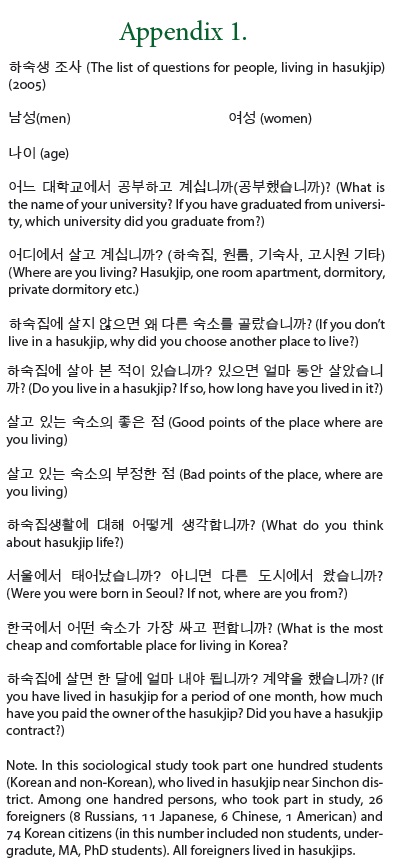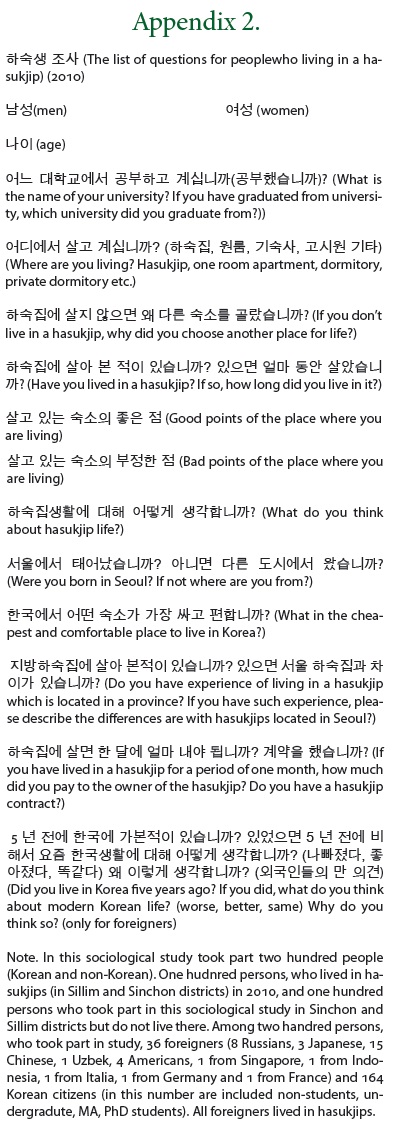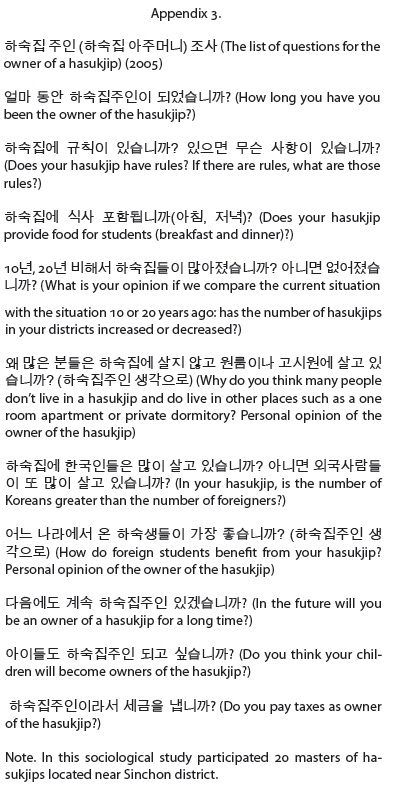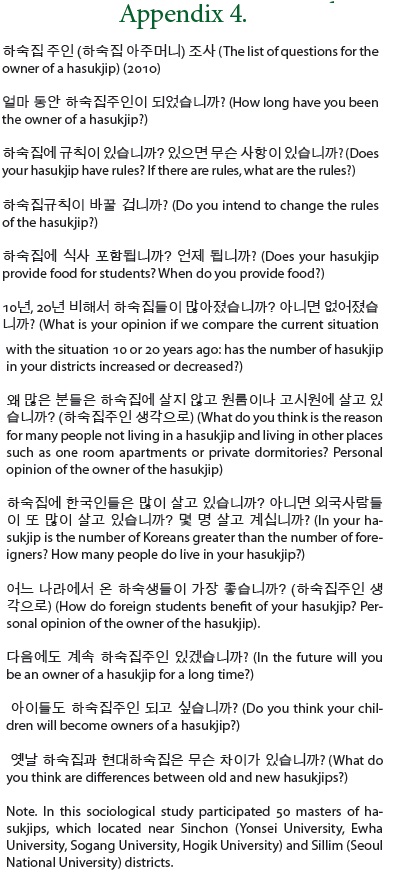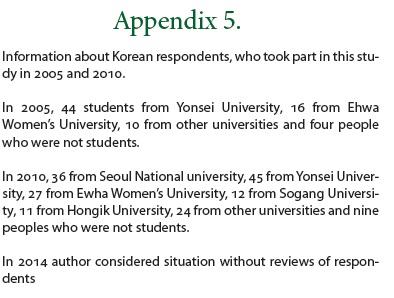Bitácora Urbano Territorial
ISSN 0124-7913
https://doi.org/10.15446/bitacora.v26n1.57106
http://dx.doi.org/10.15446/bitacora.v26n1.57106
The hasukjip: its history and current situation
Los hasukjip: su historia y situación actual
The hasukjip: sua história e situação atual
Alexander Kim
kimaa9@gmail.com
Doctor de la Academia Rusia de Ciencias (Rama del Lejano Oriente). Profesor investigador en el Instituto para el estudio de la Historia de la Universidad de Corea. Profesor asociado al Departamento de Educación Histórica de la Escuela de Educación, Universidad Federal Oriental (Rusia).
Recibido: 08 de agosto de 2015 Aprobado: 02 de octubre de 2015
Abstract
The hasukjip ( ) is a form of small business in Korea. It consists of a house with several (sometimes up to a dozen or more) boarding rooms. Many Korean and foreign students live in hasukjips. Koreans understand hasukjips only as a type of private dormitory, but if we examine how hasukjips have changed and evolved we can then understand social and housing trends in Korean society. Although hasukjips reflect elements and aspects of various sides of life in Korea, Korean and foreign scholars have never undertaken research on the history of the hasukjip nor the changes in its history. Besides this institution remains practically unknown in the Western academic world. The aim of this article is to consider elements of the history of the hasukjip and its place in Korean life.
) is a form of small business in Korea. It consists of a house with several (sometimes up to a dozen or more) boarding rooms. Many Korean and foreign students live in hasukjips. Koreans understand hasukjips only as a type of private dormitory, but if we examine how hasukjips have changed and evolved we can then understand social and housing trends in Korean society. Although hasukjips reflect elements and aspects of various sides of life in Korea, Korean and foreign scholars have never undertaken research on the history of the hasukjip nor the changes in its history. Besides this institution remains practically unknown in the Western academic world. The aim of this article is to consider elements of the history of the hasukjip and its place in Korean life.
Keywords: History, Korea, housing studies, economy, hasukjip.
Resumen
El Hasujkip: es una pequeña forma de negocio en Corea. Consiste en una casa con varias (algunas veces con una docena o más) habitaciones para alquiler. Muchos coreanos y estudiantes extranjeros viven en Hasujkips. Los Coreanos identifican los Hasujkips solo como un dormitorio privado, pero si examinamos cómo los Hasujkips han cambiado y evolucionado, entonces podemos entender las tendencias sociales y de vivienda en la sociedad coreana. Aunque los Hasujkips reflejan diferentes elementos y aspectos de la vida coreana, los coreanos y los estudiantes extranjeros nunca se han preocupado por conocer la historia de los Hasujkips ni sus cambios. Además, los Hasujkips son prácticamente desconocidos para el mundo académico occidental.
Palabras clave: Historia, Corea, estudios de vivienda, economía, Hasujkip.
Resumo
O Hasujkip: é uma pequena forma de negócio na Coreia. Consiste em uma casa com várias (algumas vezes com uma dúzia ou mais) habitações para aluguel. Muitos coreanos e estudantes estrangeiros moram em Hasujkip. Os Coreanos identificam os Hasujkip com um dormitório privado só, mas se examinamos como os novos Hasujkip tem mudado é evoluído, então podermos entender as tendências sociais e de vivenda na sociedade coreana. Embora os Hasujkips refletem diferentes elementos é aspetos da vida coreana, os coreanos e os estudantes estrangeiros nunca se tem preocupado por conhecer a história dos Hasujkips nem suas mudanças. Além disso, os Hasujkips são praticamente desconhecidos para o mundo acadêmico ocidental.
Palavras Chave: Historia, Coreia, Estudos Habitacionais, Economia, Hasujkip.
Article
The hasukjip is a house in which Korean and non-Korean persons can rent a room, usually for a minimum, of one month. The owner must stipulate the rules, such as a schedule and provide food in the morning and evening at a set time. We can consider the hasukjip not only as a form of Korean business, but also as a part of Korean life.
We do not know when the institution of the hasukjip was originally established. According to both oral history and assumptions by Korean journalists, the first hasukjips were established in the Choson period (1392-1910) (http://www.reportshop.co.kr). Based on the fact that hasukjips were usually located near universities and the general opinion according to Korean history is that the first Korean university was founded at the end of the fourteenth century. However, many Western and Russian scholars believe that Korean educational institutions did not correspond to university standards until the Twentieth century. Therefore, if we are to think that hasukjips were established only near universities, we have an estimated period of establishment for the hasukjip, being within the twentieth century. We have another problem: information about hasukjips can be proved to be true only from official histories as Korean historians did not pay attention to hasukjips and concentrated on other fields. Modern Koreans have not undertaken research on this topic; we can see only books with announcements about hasukjips, newspaper articles (Hasukjip lobby 1978; Ko1993; Korean language program 2010: 17), stories by foreigners who have lived in hasukjips, articles about incidents that happened at hasukjips, annecdotes or love stories, novels and other literature.
Hasukjip and its place in Korea
Hasukjips have a place in modern Korean culture. We can see Korean TV programmes about life in hasukjips, such as  Poseok Bibimpap, information in newspapers (like classified hasukjips' vacancy ads or actual news stories about hasukjips), several internet sites that have been set up by hasukjips themselves and so forth. The absence of official documented history of hasukjips, forces us to consider oral history and the results of sociological studies. The author of this article lived in several hasukjips between 2001 and 2015 on multiple visits and has seen the social and economic influences of Korean life reflected in the hasukjip system. To better understand the role of hasukjip in Korean life, two sociological studies were done by the author focusing on people who have lived in hasukjips (hasukseng
Poseok Bibimpap, information in newspapers (like classified hasukjips' vacancy ads or actual news stories about hasukjips), several internet sites that have been set up by hasukjips themselves and so forth. The absence of official documented history of hasukjips, forces us to consider oral history and the results of sociological studies. The author of this article lived in several hasukjips between 2001 and 2015 on multiple visits and has seen the social and economic influences of Korean life reflected in the hasukjip system. To better understand the role of hasukjip in Korean life, two sociological studies were done by the author focusing on people who have lived in hasukjips (hasukseng  , renters), the first study in 2005 (Appendix 1) and the second one in 2010 (Appendix 2). The author asked questions to hasukjips' owners in 2005 and 2010 (Appendixes 3 and 4) and performed a questionnaire for students and owners of hasukjips who lived or stayed in the following districts: Sinchon and Sillim districts of Seoul.
, renters), the first study in 2005 (Appendix 1) and the second one in 2010 (Appendix 2). The author asked questions to hasukjips' owners in 2005 and 2010 (Appendixes 3 and 4) and performed a questionnaire for students and owners of hasukjips who lived or stayed in the following districts: Sinchon and Sillim districts of Seoul.
While we do not have information to show the beginning of hasukjip, we can still consider the history of what has changed in hasukjip life.
According to the information received from various owners of hasukjips, we can see that in the 1960s and 1970s almost everyone who lived in hasukjips were male students. We can explain this situation in several ways. According to the traditional understanding of Korean morality, the percentage of female students coming from the provinces to large towns to study alone, are very minimal. If a female student came to Seoul alone, that would be considered a moral infringement. We must note that in Korean culture women may be less valued than men and parents often provide better education to their sons than to their daughters. Many Korean parents think a son will support them in their old age while a daughter -once married- will only worry about her new family. Other reasons for living in hasukjips include the high cost of the expensive tuition fees at Korean universities, the problems faced by the Korean economy during these years and other economic issues. Certainly at that time there were a few female-only universities in Korea, but the number was minimal and the students of these institutions were able to live in the universities' dormitories.
After the 1970s and 1980s the situation in the Republic of Korea significantly changed. Economic development and western influences led to changes in Korean life. The number of female-only universities had increased and a large number of female students had come to hasukjips. Almost all of the hasukjips' owners were elder women with children; therefore many female students pondered life in hasukjips as very safe, friendly yet free of parental supervision. Many hasukjips were co-ed divided into women's and men's floors whilst other hasukjips were fully unintegrated (male only or female only). Almost all female students who did not have relatives in Seoul or other big cities, lived in either hasukjips or the university dormitories. By the 2000s, many of the female students who lived in Seoul begun to live in hasukjips. In 2005, 20% of Korean female students who lived in hasukjips had a family house in Seoul, but stayed in the hasukjip because they sought to be free from parental supervision. However, ancient and social traditions, such as those on the role of men vs women were still prevalent even if outdated. During the lapse from the 1980s to the 1990s many hasukjips continued to segregate men from women. This system had almost disappeared by 2010 under the influence of modern trends. In 2010, 50% of female students who had arrived in Seoul from other cities, and had taken part in this sociological study lived in one room apartments.
The increase in the number of hasukjips during the 1980s and 1990s gave rise to several new tendencies and changes in ha-sukjip life. Hasukjips became a favorite form of small economical activity and many people, who had not previously engaged in this particular small business, became owners of hasukjips. This economic activity is pondered convenient because owners do not pay property tax and people who live in hasukjips are not required to register their residence there. Moreover, 90% of all rent payments are dealt in with cash, thus; the bank system does not have information about the profits from hasukjips and it is only through the contract system that we can understand the extent of the financial position of the owner. Since the 1980s some owners of hasukjips began to refuse the contract system. Usually a student who wants to live in a hasukjip must make a contract for the period in which he or she wants to stay. While the period in which a resident can live in a hasukjip must be clearly specified, the contract may include further conditions, such as clauses for the student residents who may return to their hometown for two weeks or more (to refund part of the rent payment), personal information of residents of hasukjip for the owner, and more. Recently, the tendency to not sign a contract has become widespread and many owners no longer use a written contract. Contracts between students and landlords/landladies are done only verbally, a conversation must take place before their trip when all conditions and rules are stipulated. Between 2005 - 2010, 80% of foreign students who lived in hasukjips had a verbal agreement with their landlords or landladies.
It is likely that this change has affected the period the students are allowed to live in hasukjips. In 2001 - 2005, the residents of hasukjips and owners worked together to decide how many months the residents would live in the hasukjips. Usually the contract limited their stay to a period of three to six months, but some students lived in hasukjips for several years. Many owners refused people who wanted to live in the hasukjip for a short stay of only one or two months. Between 2005 - 2010 the situation changed again and according to a verbal agreement a resident could stay for one month or in special cases as short as two or three weeks.
Certainly many owners have tried to improve the reputation of the hasukjip. We can see chapters about hasukjip life in Korean language textbooks for foreigners, in the sections about Korean life. This is evidence that many Koreans understand that ha-sukjips are part of the Korean life and have tried to give information about them to foreign students. Hasukjip owners have established internet sites in both Korean and English, and have made efforts to attract foreigners. For example, many foreigners in 2005 thought that the landlord or landlady of the hasukjip was very friendly (60%), and some students said they had been refunded for part of their rent payment because they had not eaten on-site frequently during the preceding month. According to ordinary hasukjip rules not having breakfast or dinner is up to the individual student. Operators of the hasukjip provide breakfast and dinner on time and bear no responsibility for students who are late. However, in 2010 only approximately 40% of foreign respondents thought that the operators of hasukjips were friendly.
In many hasukjips, two students can live together in one room to save money, although most owners do not like if male and female students want to live in one room. Because a hasukjip is a place primarily for students, not for lovers, the owners want to uphold the reputation of hasukjip in line to the rules of Korean morality. The author of this article witnessed situations where landlords or landladies turned out students who lived with their couple in a single room without permission because, in the owner's opinion, such activity was immoral.
The hasukjip system has witnessed many social changes and has therefore evolved and seen its rules changed accordingly. The increase in the number of hasukjips became an important factor in the crisis of this institution. Among the new owners are many people who lack the knowledge of the traditions and moral values of the original hasukjips and they do not want to abide to them. Many of the new generation of owners regard hasukjip solely as a source of money. They have made many changes in the system of hasukjips. As many of the new owners have mostly focused on the financial aspects of hasukjip life, they have ignored safety conditions and the comfort of students living in the hasukjip in order to make more profits. This situation has been reflected in the results of this study. For example, in 2010, 14% of the respondents thought that hasukjips had become uncomfortable but in 2005 only 2% thought so. This has played a major role in the reputation of hasukjips. According to sociological results, many students preferred to live in hasukjips in 2005 (32%), but only 14% of respondents wanted to live in hasukjips in 2010. We must note that many young Koreans don't hold the moral rules of their parents and would like a separate life -with amusements and freedoms.
These results demonstrate that the hasukjip has lost its demand among Korean students, because according to the information received from respondents in the 2010, the hasukjip became cheaper but more uncomfortable (10%), did not provide food or if it was provided the cooking was considered very bad (8%), and masters of the hasukjips did not properly control the houses. There has also been an increase in the number of criminal incidents, like larceny and sometimes robbery. Between 2005-2010 criminal incidents occurred in 20% of hasukjips where owners and residents took part in this sociological study. Few Korean students believe that the operators of the hasukjip were not friendly (6%). In 2005, 50% of operators kept rules for hasukjips (such as students must close the main door of the hasukjip at night, must not make any disturbance after 11 pm, and so forth), but in 2010 only 10% of hasukjip managers insisted on such rules. Moreover, recently many hasukjips have not provided food. In 2005 - 20 % did not provide meals, in 2010 - 50 %, and in 2014 - nearly 70 %. For this reason, in 2010, many students preferred other living arrangements near universities, like one room apartments ( ) (24%) or private (goshivon,
) (24%) or private (goshivon,  ) and university dormitories (30%). Certainly, many students recognize that a hasukjip is cheaper than a one room apartment, but is not nearly as comfortable (28%).
) and university dormitories (30%). Certainly, many students recognize that a hasukjip is cheaper than a one room apartment, but is not nearly as comfortable (28%).
The owners of hasukjips have recognized that recently, their numbers have decreased. In 2005, 75% of owners thought that the number of hasukjips had increased but in 2010 only 6% held the same opinion. Alternativly, in 2005, 10% of owners believed that the number of hasukjips had decreased, but in 2010, 90% of owners who took of part in this study had the same opinion. Some hasukjips have since been converted to one room apartments or private dormitories.
We must note that the younger generation in Korea, who were born after the 1970s, do not like cooking and often look for an easy life. Many owners (approximately 60%) think that cooking is tiresome and onerous. As a result, many new owners of ha-sukjips do not like cooking and do not maintain the traditions of hasukjips. The cost of food in a hasukjip for one month is not high - from around 50.000 - 100,000 won, but many owners believe that cooking in hasukjip is an unnecessary expense. Many students have other opinions - 18% of Korean students are prepared to live in a hasukjip if the owner provides good food. Almost all foreign students who have experienced living in a hasukjip chose the hasukjip because it provided food.
The deterioration of conditions in hasukjips has influenced the ethnic component of the people who live in hasukjips. We can see the process of the decrease in the number of Japanese students living in hasukjips, which was at in 2005 - 11% and in 2010 - 3%. Japanese students who live in Korea and study the Korean language or post-graduate courses, usually like comfortable conditions. They are not trying to save money in terms of where they live and many have taken up residence in one room apartments. However the number of Chinese students who live in hasukjips has increased - from 6% in 2005 to 15% in 2010. This information reflects trends in Seoul hasukjips. (It should be noted that in provincial hasukjips we see another situation, described later in this article.)
In spite of both inflation in Korea and the world financial crisis, many Korean hasukjips were able to hold the cost of their rooms at the same prices as in 2005. We can be certain that hasukjips, as an institution, are very stable. Alternately, modern influences resulted in changes in the original hasukjip system. The children of hasukjip owners do not want to continue to own hasukjips (in the opinion of 100% of the owners) and among the owners of hasukjips polled, only 10% had owned hasukjips for more than 10 years. Modern masters do not support hereditary traditions in hasukjips. This short period for owning hasukjips also explains the problems in understanding hasukjip history, along with the uncertainty about the period in which the hasukjips were first established.
During the 2000s, the profile of people who live in hasukjips has changed. In 2010, out of the people who lived in hasukjips, there has been an increase in the number of people working and not studying at educational institutions (in 2005 - 4%, in 2010 - 9%, and in 2014 - 15%). Recently, many residents of hasukjips are people on business trips in Seoul from other Korean cities. Historically, Korean people working in companies and offices did not live in hasukjips and chose one room apartments, because Korea has social rules about the stratums of population. People who worked in companies did not live in places intended for students. But now, as we can see, the traditional Korean stereotype has changed.
In 2005, many male Korean students considered hasukjips to be good places for meeting new friends, with the possibility of meeting potential girlfriends. This was impossible in 2001. The same situation is common from women's side. The author of this article knows several families that began their relationships after meeting in hasukjip.
Other changes appear in personal contacts between the people who lived in the hasukjip. In 2005, almost all the students who lived on one floor of a hasukjip knew each other and could say their neighbours' names, or at least the majority of them. After 2010, personal contact between residents of the hasukjip became weak. The author of this article discussed this with several students and found they did not know the names of the people that lived on the same floor in the neighboring rooms. This is the result of the new tendencies in the hasukjip lifestyle. One reason may be that recently the popularity of computer games in Korea has grown. Many young internet gamers have moved into hasukjip because they find them convenient. In most family houses parents do not like when their children play video games for many hours in one day, but in a hasukjip a computer gamer has good conditions: he can live alone in a separated room, he doesn't have to worry about parents or food, the internet in al most all hasukjip is free, and so forth. Clearly, this type of student is not likely to want to establish personal contact with others who live in the same hasukjip.
The number of students who use hasukjip only as place to sleep and do not have either breakfast or dinner has increased. Thus, as we can see, hasukjips have changed greatly during the 2000s, but still retain their basic function and have developed along with the social changes in Korean life. The popularity of hasukjips among Korean students has fallen when compared their popularity between 2001 and 2005.
Foreigners and hasukjips
From the 1990s onward, many foreigners began to live in ha-sukjips. In the 1990s, the hasukjip had very good conditions. Foreign students lived in hasukjips cheaper than in dormitories and could practice their Korean language skills, as nearly all of the operators could not speak English, and many Korean students lived in hasukjips. As we can see, the hasukjip was favorable for foreigners. It was not expensive, usually between 300,000 to 400,000 won for one month from 2001 to 2010, or approximately 250-333 USD. In 2001, the cost was about 300-400 USD, from 2005 to 2010 it costs between 250-350 USD, and around 280380 USD in 2014).1 Hasukjip owners do not discriminate against foreign students and payment for a room is usually identical for a Korean and a non-Korean renter.
Despite the deterioration of the conditions in hasukjips, many foreigners still live in them because hasukjips costs have not changed much. Many hasukjips located in the Sinchon district are oriented specifically toward foreigners and at the end of 2008, 63,000 foreign students studied in Korea (Kang 2009).
The hasukjip is a very usual place for Koreans to live. Many Korean students who have arrived in another country for the first time prefer to live in hasukjip. As a result, we can find hasukjip in large cities, such as Moscow and Los Angeles, but usually they are only for Koreans. Certainly, the price for the rent of a room is very different from Korean hasukjip. In our opinion, the hasukjips located in other countries can give Korean students, staying in foreign societies, the possibility and time to adapt.
Differences between city and regional hasukjips
There is a clear difference in the prices for hasukjips in country versus city areas. The author visited both provincial hasukjips, in which a student could live for 200,000 won for one month in 2001, and in Seoul hasukjips where a room cost 500,000 won for one month. Many hasukjips provided food, usually breakfast and dinner, but many hasukjips located in provinces also provided lunch. People who lived in hasukjips paid only rent for a room and did not pay for utilities (gas, water, etc). Almost all hasukjips were located near universities, which were very comfortable for students and other residents, many of whom had to travel by train, bus, or metro. Almost all hasukjips had free washing machines, internet connection, and cable television. Some hasukjips had further additional amenities. We can consider the increase in the number of the foreign students in hasukjips (from 26% in 2005 to 36% in 2010) from this perspective. Certainly, university dormitories and private dormitories (koshivon) are cheaper than hasukjip, but dormitories do not provide food and the students must live with a roommate. The hasukjip is popular amongst foreigners, although we must note the cultural and individual differences of foreign students are sometimes not ideal for living in hasukjips.
Conclusion
In spite of the crisis it has recently faced, the hasukjip system has maintained its place in Korean life. It is certain that the hasukjip will not disappear but will greatly change. Absence of the hereditary traditions in the hasukjip has caused a lack in recoreded history, therefore we must rely oral information2.
Certainly, the hasukjip system will continue to evolve, because they must be oriented to new tendencies in order to keep up with the category of young users, increased number of foreign residents and more.
Notas
1 Changes of price of the rent room in the hasukjip depended of current balance between USD and Korean won.
2 Some information has been received in the process of conversations with owners and residents of hasukjips. Certainly this information was not reflected in the list of questions in the studies of 2005 and 2010.
Literature
Korean language program (2010). Seoul: Yonsei university press. [ Links ]
In Korean periodicals Hasukjip lobby ( ). 1978-11-09, in: The University's newspaper of Seoul National University
). 1978-11-09, in: The University's newspaper of Seoul National University Links ]jpg" align="absmiddle">).
Ko Je-seok ( ). 1993.05.10. The Hasukjip in which love has blossomed (
). 1993.05.10. The Hasukjip in which love has blossomed ( ), The University newspaper of Seoul National University (
), The University newspaper of Seoul National University (Links ]jpg" align="absmiddle">).
Kang Yun-ju ( ). 2009.12.09. Seoul, Sinchon, the hasuk village is popular among foreign students (
). 2009.12.09. Seoul, Sinchon, the hasuk village is popular among foreign students ( ), Korean newspaper (
), Korean newspaper ( ), Internet resources http://www.reportshop.co.kr/data/data_view.html?rpID=8874. [ Links ]
), Internet resources http://www.reportshop.co.kr/data/data_view.html?rpID=8874. [ Links ]













